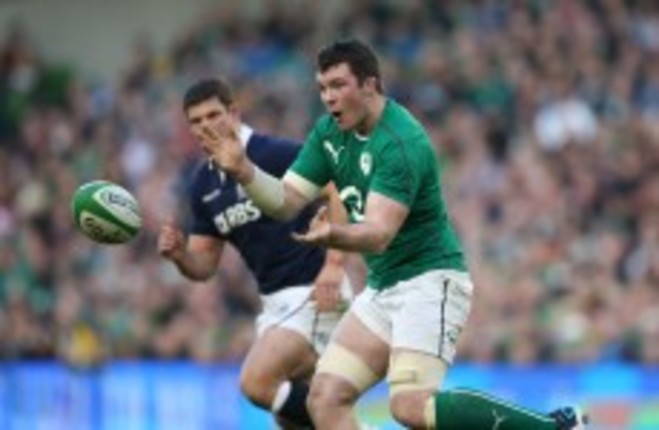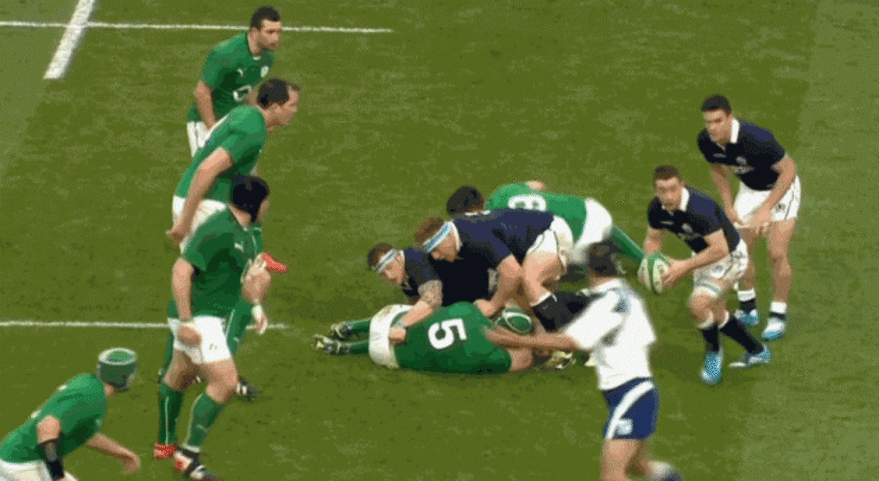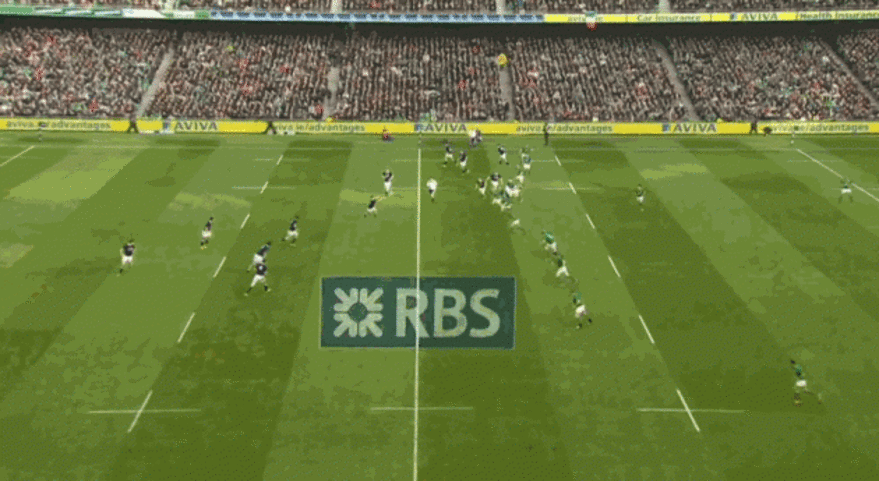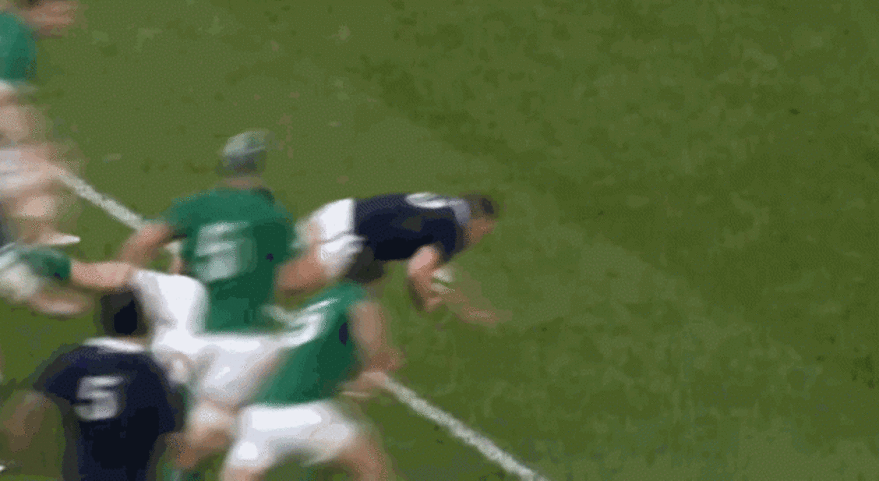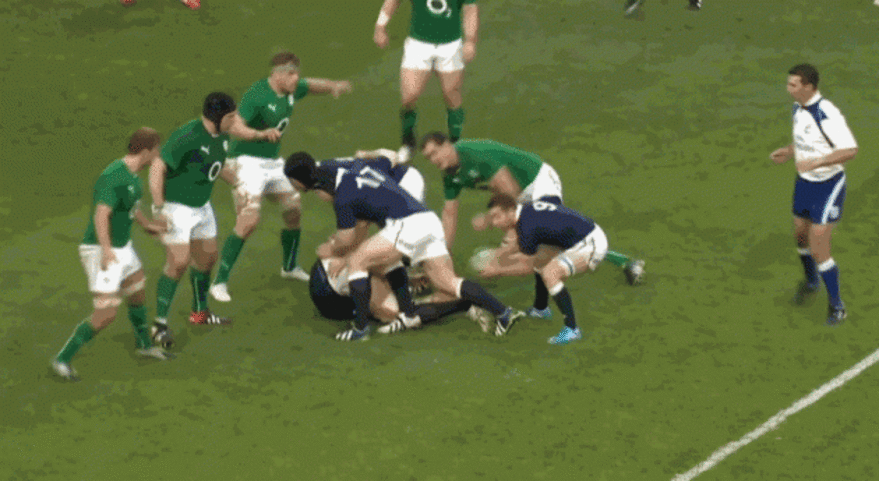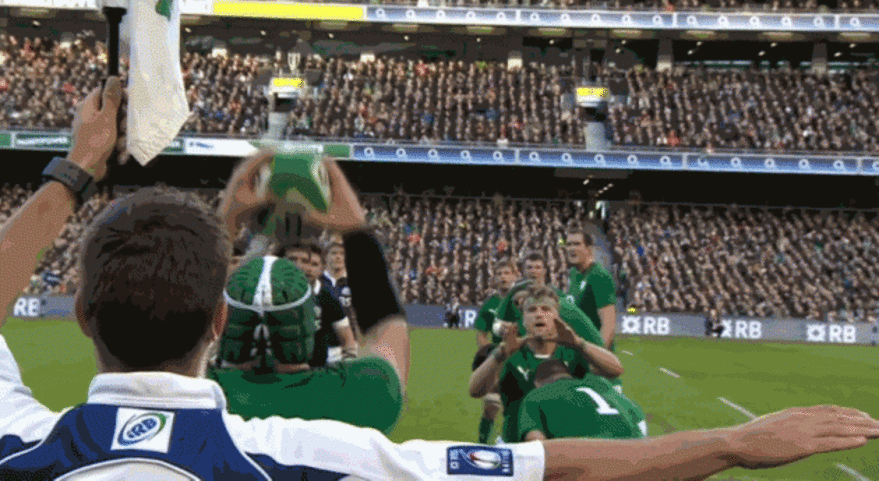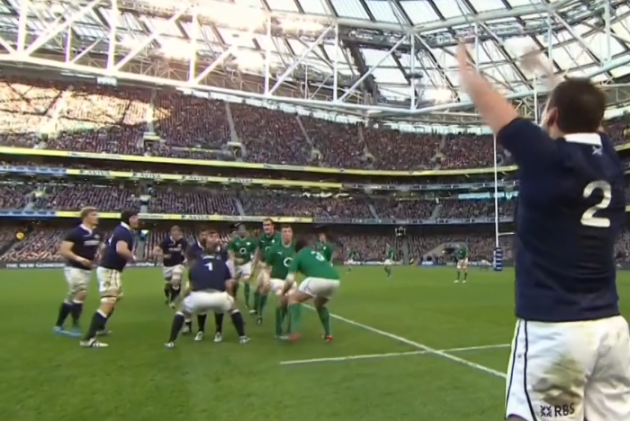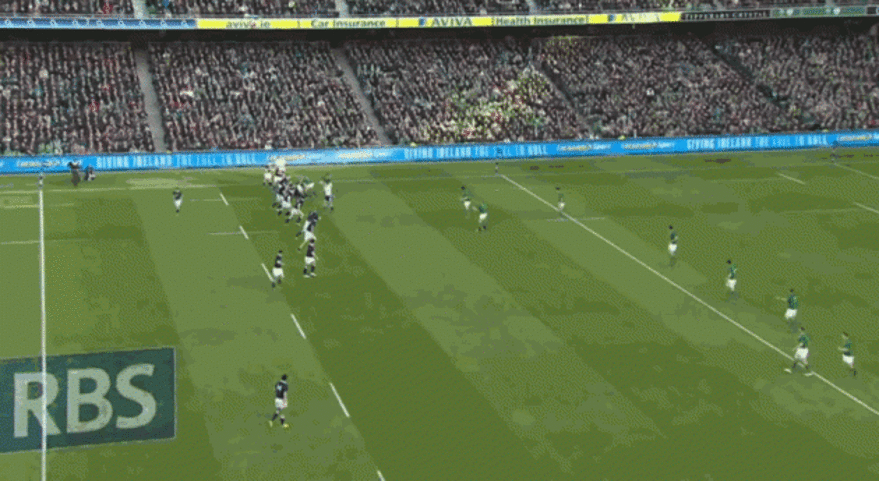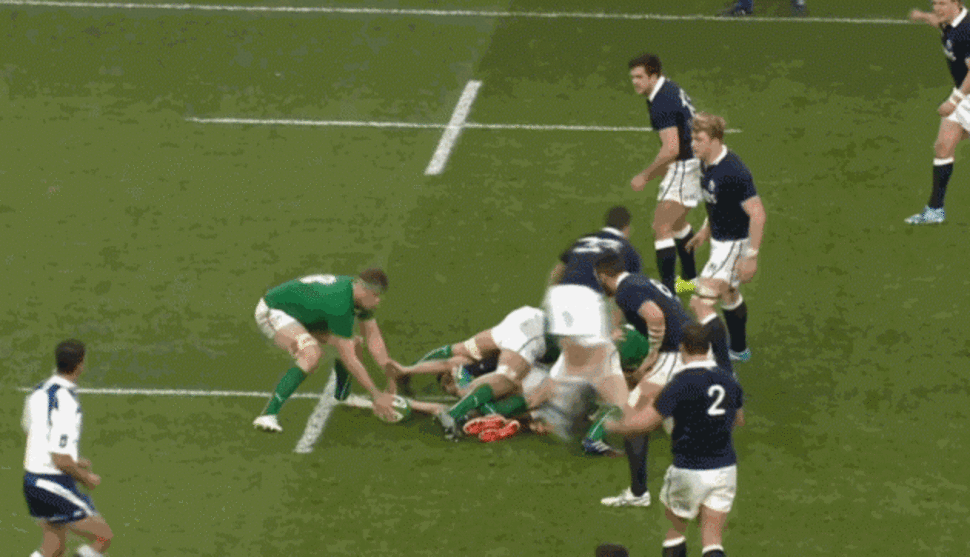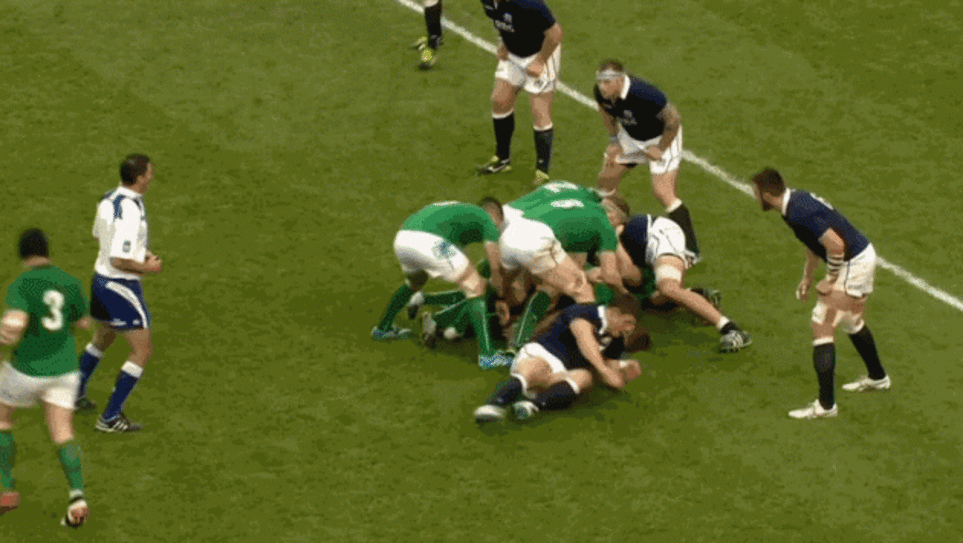ONE OF THE great fears for Ireland supporters heading into this Six Nations was, and probably still is, the absence of Sean O’Brien.
Explosive ball carrying is the most commonly cited attribute in terms of his impact on games, but the Leinster man is a truly complete back row player. O’Brien tackles well, steals possession at the breakdown, hits attacking rucks with ferocity and has good passing and offloading skills too.
The fact that his shoulder injury sees him missing for the entire competition means other players are going to have to step up to cover the workload that the Tullow native normally gets through. In that regard, Peter O’Mahony put in a phenomenal shift against Scotland to help Ireland eventually dominate.
Here, we detail the Munster captain’s every action on the pitch last weekend. There were countless excellent contributions but there are, of course, areas in which O’Mahony will look to improve against the powerful Welsh on Saturday.
Tackling
One-on-one tackling has been one of the relatively weaker areas of O’Mahony’s game since he broke onto the professional scene. Whether it is a technique or confidence issue [we suspect the former], the 24-year-old does not hit with the same level of impact as someone like Stephen Ferris or Chris Henry.
That is not necessarily such a bad thing; not every player can be a Brian Lima-style rib-crushing tackler. However, O’Mahony certainly has the power and aggression to contribute a little more in this department. Against Scotland, the Munster back row completed nine tackles, five of which involved another Irish defender.
The really positive aspect of the tackling was that three of those efforts were strong, ball carrier-halting tackles, while one of them was truly dominant. That hit [below] was one of those in which O’Mahony was ‘assisted’, with Cian Healy the other defender involved.
While Healy possibly played the more prominent role in this tackle, O’Mahony’s extra power certainly made a telling difference in driving Ryan Wilson back into the dirt. The Cork native dips his body before the contact, coiling up and then unloading a nice shot into Wilson’s upper body with his right shoulder.
The three other tackles of O’Mahony’s that we counted as ‘strong’ were not as spectacular, but they did demonstrate his developing grappling skills. The 24-year-old’s constantly improving upper body power is helping him to wrestle in contact far more effectively.
There were two low tackles from O’Mahony against the Scots, both of them in wide channels where it is far more difficult to be dominant and get good leg drive into the hit. The example below shows the Ireland blindside picking out Sean Maitland, tracking him across the pitch then taking out his legs at the knee.
It’s the perfect type of tackle in this situation, where an attempt to go in high on Maitland may have led to being handed off. Again, these are encouraging signs as O’Mahony picks out the ideal tackle in the circumstances and carries it out effectively before springing to his feet to compete for the ball.
There were two missed tackles on Sunday from the number six, although one of them was inconsequential and in a difficult situation. Not that missed tackles are to be readily accepted in certain scenarios, but O’Mahony was chasing hard off a loose kick and just slipped off Sean Lamont on his exposed inside shoulder.
There was plenty of cover for Ireland and it wasn’t particularly damaging. Little misses such as that one happen all the time in rugby. More concerning was the missed tackle on Stuart Hogg in the 57th minute, where O’Mahony had the opportunity to put in a really dominant hit on the fullback but was brushed off.
Hogg is a wonderful counter-attacker and a tricky customer for any defender, but on this occasion he runs directly into O’Mahony. The Irishman appears to get his head on the wrong side of the tackle [something which has got him knocked out in the past] and awkwardly falls off the tackle.
This miss is a little more concerning as it’s exactly the type of situation you would want your back rows to find themselves in; a one-on-one chance to smash the oppositions’ best attacking player and possibly even win a turnover. O’Mahony will have studied the reasons for the miss and is certain to have learned from it.
Breakdown
This was the area of the game in which O’Mahony really stood out as a leader for Ireland. In defence, the flanker competed at the breakdown on seven occasions and won turnovers on three of those. O’Mahony counter-rucked to disrupt Scotland’s quality of possession once, while he was blasted off the ball another time.
The seventh involvement at the breakdown in defence saw him come extremely close to a further turnover, and many referees would have awarded O’Mahony the penalty. Craig Joubert opted to allow Scotland the chance to redeem the situation, which they did by ripping the ball back out of the Irishman’s grasp.
O’Mahony’s first turnover of possession came as early as the sixth minute, as he pounced on the briefly isolated Duncan Weir inside Ireland’s 22.
It’s an excellent turnover and a very timely one after Scotland have cut Ireland’s defence from a quickly-taken line-out. O’Mahony comes all the way from behind the ball, around the ruck and in ‘the gate’ to beat the Scottish ruckers to the ball [close up below].
He snaps down into that ‘jackal’ position and rips the ball clean from Weir’s grasp. We see less and less of this every season as ball carriers choose to hold onto the pill and concede the turnover penalty. While the rucking by Scotland was atrocious in this instance, it was a wonderful effort from O’Mahony and a sign of things to come.
The second O’Mahony turnover arrived in the 35th minute and this time the penalty was awarded. As you can see in the video below, it briefly looks as though Ireland will pull off their famous choke tackle, and O’Mahony steps towards the collision with the idea of getting involved in that action.
As he does so, the tackle goes to ground and again, the Munster man’s reaction is swift and decisive. He immediately targets the ball and again assumes a powerful jackal position. You can see that Greig Laidlaw feels O’Mahony hasn’t detached after being involved in the tackle, but referee Joubert reads it differently and Ireland get the penalty.
Finally, we had another excellent O’Mahony turnover in the 58th minute, literally phases after the missed tackle on Hogg highlighted above. To respond in such a manner is typical of the determined flanker, and he combined that will with strong technique again.
Luke Marshall makes a soak tackle on substitute Johnnie Beattie in midfield, allowing Scotland over the gainline and really getting them onto the front foot. However, the No. 8 gets detached from his support and O’Mahony is lighting quick in recognising that.
The Irishman spots the opportunity so early that by the time Scotland’s would-be rucking players arrive, the turnover is already as good as completed. They are greeted by the sight of O’Mahony’s back as he leans in over the ball to win the ball, with Joubert awarding Ireland the penalty again.
Line-out
While the Munster man was busy making up for O’Brien’s absence in terms of stealing Scottish possession, the line-out is one area where he is marking himself out as more effective than the Leinster back row. O’Mahony had 12 direct involvement out of touch, including defensive situations and Ireland’s own throw.
The blindside claimed the ball thrice, including one steal of Scotland’s possession. One of his catches on Ireland’s throw came at the tail of the line-out, while the other was at the front. There was another occasion on which O’Mahony’s jump was perfect, but Rory Best just overthrew him at the tail of the set-piece.
The Munster man’s excellent handling skills and springy leap make him an ideal target for playing directly off the top at the back of the attacking line-out. Backs everywhere in the world crave that kind of possession as it grants them extra time and space on the ball.
The example above gives us a strong example of what O’Mahony can deliver in that regard. There are real shades of a classically French back row in his line-out ability; many French teams will select one of their back rows specifically for their jumping skills and some flankers will even call the line-outs in L’Hexagone.
Defensively, O’Mahony got into the air properly on two occasions, one of which yielded that steal of the Scottish throw. It was all about his anticipation and reaction again; he reads the line-out particularly well and on this occasion he was accurate in predicting where the Scots would throw to.
O’Mahony doesn’t manage to hang onto the ball, but he does knock it back on Ireland’s side. The speed of his reaction actually meant that he didn’t get the strongest lift at the back from Devin Toner. In the shot below, you can see that O’Mahony is already planting his feet to spring into the air while the Leinster man is still trying to follow him to the front.
There is more to a functioning line-out than accurate throwing and explosive jumping; the lift is an essential part of the machine. O’Mahony made five lifts against Scotland, all of them behind Devin Toner and all of them resulting in clean possession for Ireland.
Toner is a superb jumper and his gangly frame makes him ideal for lifting, but it’s still a laborious task that requires lots of strength. Those five lifts were the least glamorous part of O’Mahony’s afternoon, but they were just as important as his turnovers in helping Ireland to enjoy a stream of possession out of touch.
Rucking
While we have seen that O’Mahony was busy at the breakdown in defence, he also got through a mountain of work at attacking rucks too. We counted 20 rucking involvements from O’Mahony over the course of his 65 minutes on the pitch, with a varying degree of success.
There was one really ‘dominant’ clear out [below] of a defensive player, while seven others were ‘effective’ in removing a defender. We marked four of O’Mahony’s rucking efforts as ‘inneffective,’ meaning he either failed to prevent a turnover or was sloppy in removing a defender with optimal speed.
On eight occasions, the flanker played the role of ‘guard’ at Ireland’s attacking rucks, not actively engaging with any defenders or clearing out a threat, but instead hovering over the ruck and providing safety for his scrum-half.
Overall, it was a good performance from O’Mahony in terms of attacking rucking, although he will look to improve his rate of success as the Six Nations continues. Seeing more aggressive rucking like the example on Duncan Weir in the video above would be greatly welcome.
Passing
When we studied O’Mahony’s performance against Samoa for Ireland in November, one of the key aspects of his role was as a linking player, making passes to draw in defenders before releasing the backs. There was only one example of such an action against Scotland, and a successful one at that as O’Mahony found Jonny Sexton out ‘the back door’ behind two decoy runners.
That aside, the Munster captain completed four passes, all of them accurate. One of O’Mahony’s strengths is his handling ability and we have commented before that he could probably do a fine job as a centre. The 24-year-old is entirely comfortable in passing off either side and over lengthy distances.
The example above may seem like a simple action to highlight, but O’Mahony’s pass in midfield [he's the guy who waves his hand in the air at the very beginning of the GIF] is one that other forwards might have struggled with.
The fact that O’Mahony is calling for the ball so early is also a sign that he has seen the space wide on the left and understands that Ireland need to attack there. Many forwards, and lots of backs, struggle to really ‘see’ space on the pitch, but it’s not a problem for O’Mahony, a fine footballer.
His handling skills were apparent as he ran a little loop move with Jonny Sexton [below] in the second half. It’s also worth noting the nudge O’Mahony gets in on a defender after he has passed to his out-half, looking to disrupt Scotland’s line as much as he can despite play having moved past him.
O’Mahony’s other two passes were from the the bases of rucks, hitting a fellow forward on a short line. Both were accurate and in front of the ball-carrier.
Scrum
There weren’t a huge amount of scrums on Sunday, with the two sides having four each. While this is generally the domain of the locks and props, the back row can have an effect on the outcome if they are part of a well-timed shove.
O’Mahony was involved in seven of the scrums against Scotland, two of which he detached himself from early in preparation for defending or getting in support in attack. On three other occasions, the flanker stayed down with his shoulder binded to his prop, but didn’t appear to make any significant effort to drive.
The three times he did drive with power, there was a noticeable improvement on that side of the scrum for Ireland. The video below demonstrates one such example, with O’Mahony dipping his hips and really driving up through the back of Cian Healy.
While the loosehead prop and Devin Toner behind him deserve the majority of credit here, every little helps. Ireland go forward on that side of the scrum and cause real problems for the Scots. The tackle O’Mahony then completes is the one we referred to earlier in the article, showing off his grappling skills in the tight.
Carrying
O’Mahony carried the ball into contact on six occasions against Scotland, breaking through two tackles and doing well every time. We have become accustomed to the Munster man operating in wider channels, but his carries against Scotland were all close to the ruck or in midfield.
Twice, Ireland used him in the middle of the pitch after receiving re-starts, including the first kick-off of the game. The second of those carries is shown in the video below. O’Mahony performed well in this mini-role, taking the pass from Sexton, making positive yardage both times and breaking Laidlaw’s tackle here.
The other two times O’Mahony was used as an attacking ball carrier were closer in to the ruck, taking the pass off scrum-half Conor Murray and surging forward. Again, these carries were effective and the example below sees O’Mahony using his aggression and upper body strength to fight off Kelly Brown’s tackle.
Uncharacteristically for him, O’Mahony didn’t actually rack up many metres gained with ball in hand in this game, mainly because he didn’t feature in those wider channels. The two carries we have not mentioned so far were scrappy ones where the Munster captain was cleaning up spilled possession and wasn’t actually a designated carrier.
As we saw for his near-try after that wonderful Sexton linebreak in the first half, Jamie Heaslip is quite often the man who maintains width for Ireland from the back row. O’Mahony is certainly effective in open space, but last weekend he was busy elsewhere.
Backing it up against Wales
O’Mahony had a superb game for Ireland last weekend, there can be little doubt about that. His work rate was phenomenal and some of the scrapping he did around the ruck area was vital. Similarly, his efforts in the line-out were important, while he demonstrated that he can affect the scrum too.
We highlighted his performance against Samoa as quite probably his most dominant in an Ireland jersey, but this display could certainly challenge that assertion. The next test for O’Mahony’s progress is standing out in a game like the one that faces Ireland on Saturday.
Dishing out pain to the likes of Scotland and Samoa is crucial, but hammering into a team as good as Wales and making a genuine difference to the outcome is the ideal basis on which to judge O’Mahony’s importance to Ireland. He will launch himself into the challenge with typical aggression, desire and skill.
